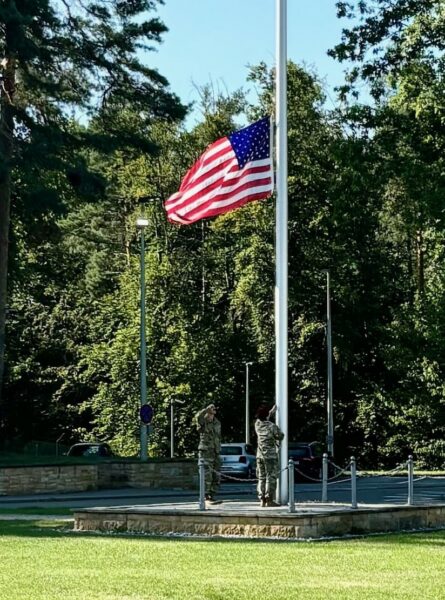
By Dayna E. Rowden
USAG Stuttgart Public Affairs
You may have noticed a bugle sounding a few times a day on USAG Stuttgart installations. For our Soldiers, hearing bugle calls on an Army installation is nothing new. Our other garrison residents and the surrounding community, on the other hand, have had some questions.
Why is USAG Stuttgart playing bugle calls?
Bugle calls have been an important tradition since before the Revolutionary War. Installations around the world use the bugle calls to pay tribute to the American flag and as a reminder of the sacrifices Soldiers make every day.
What time will the installation play the bugle calls and what should I when I hear the bugle?
- 0630 (6:30 A.M.) Reveille: The morning bugle call signals the raising of the American flag and roll call. It was originally conducted as “Troop” in 1812 and was designed to muster the unit, but as time passed, it came to mark when the flag was raised in the morning and called Soldiers to pay honors to it.
- 1700 (5 P.M.) Retreat: This bugle call, consisting of two parts, “Retreat” and “To the Colors,” signals the end of the workday. It is traditionally the time to secure the flag and pay respect to what it stands for.
- 2200 (10 P.M.) Taps: Taps is played alone at the end of the day to honor service members who paid the ultimate price.
What do I do when I hear the bugle calls:
- Reveille and Retreat
- When driving on post: Safely and slowly stop your vehicle when Reveille begins. Stay in your vehicle while the music plays and proceed once it has finished. Do not attempt to drive around stopped vehicles.
- Service members in formation: Execute the commands of the officer or non-commissioned officer in charge.
- Service members in uniform but not in formation: At the first note of music, face the flag (or direction of the music, if the flag is not visible). For Retreat, stand at attention. When “To the Colors” begins, render a hand salute and hold this position until the last note of music has been played (in the same fashion as for the national anthem).
- Civilians and service members wearing civilian clothes: For Reveille and Retreat, anyone in civilian clothing should remove headgear (holding it with the right hand over left shoulder) and face the flag or the direction of music. Following Retreat, when “To the Colors” begins, place the right hand over the heart until the last note of music. Service members and veterans may render a hand salute rather than placing their hand over their heart.
- Taps: There are no formal protocol procedures required. When you hear the music, however, try to remember our veterans and those who gave the ultimate sacrifice.
The bugle calls have been very loud. What is the garrison doing about that?
The garrison is using its public announcement system to play the bugle calls. In response to feedback from our installation residents and members of the surrounding communities, we have turned off the sound system for all speakers that are in installation housing areas and turned the volume to a one (on a scale of 1-10) for all other speakers.
What is the history of the bugle calls?
According to the ArmyLive website, by the time George Washington first assumed command of the Continental Army in 1775, drums and bugles had already been a fixture of military life and operations as a way for a commander to communicate his orders over the noise of battle.
The U.S. Army later standardized the use of these bugle calls for a disciplined lifestyle. These customs and courtesies have long fostered a greater sense of community on U.S. Army installations around the world. They offer Soldiers and family members the chance to unite several times a day to honor the flag of our nation.
While the sound of the bugle may stop us momentarily from what we are doing, the tradition and honor that accompanies the music deserve a moment of our time.
